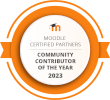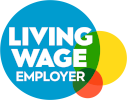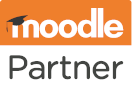How to sign up for ELD services
Choosing a Moodle services provider can be a slog, particularly if you’re new to e-learning. Quite apart from figuring out what the terminology all means, you’ll need to be able to pick an appropriate hosting package, investigate startup support options, identify potential technical requirements, and compare the various costs… And as part of the process, you’ll naturally be assessing the potential providers themselves.
Why choose e-Learn Design?
We’re the Moodle experts; you’re the subject matter expert in your field. Our job is to provide the technical know-how that gets your expertise online in a powerful and engaging learning experience. And we’ve been doing just that – in a wide range of sectors – since 2007.
We value transparency. That’s why our prices are all clearly listed. You’ll know exactly what you get, for how much, and for how long – no hidden costs, no pricey extras.
We prioritise cost efficiency. Both for ourselves and our clients. We won’t sell you something you don’t need, and our scalable services are designed to suit all budgets.
We believe e-learning is a right, not a privilege. Everything we do is focused on helping you get your learning online as efficiently and effectively as possible.
How do I sign up for services?
We’re a Moodle Certified Partner dealing with commercial requests on Moodle’s behalf. That might seem like a mouthful, but everything else is easy to digest. So, as we like to make sure you always know what to expect, here’s our signup process – from first contact to completion.
1. Get in touch.
Tell us in writing what you’re planning, and we’ll send you details on how we can help. Read them over, have a think, and if you want a call to talk options, we’ll arrange a convenient time via email.
2. Have a quick call (if you want one).
These usually last between 30 and 60 minutes, and you’ll be speaking to a Moodle expert, not a salesperson, so you can be assured of practical answers to any questions you may have. If you don’t need a call, skip to…
3. Request a Quote.
We won’t ask for your budget, even if your needs are very complex. Our services are modular, and our prices clearly published, so a Quote is simply confirmation in writing of exactly what you’d be getting.
All look good? Keen to get Moodling? Then the last few steps are quick…
4. Once you accept the Quote in writing, we’ll send you logins to the ELD Moodle Space to accept our Data & Security policies.
5. If you’re migrating an existing site, we’ll coordinate a day/timeslot to mitigate downtime impact; if it’s a new installation, set-up will be within 24 hours of Quote acceptance (M-F*).
6. As long as you’ve accepted our Data & Security policies, as soon as the site is live on our servers, we’ll send you access logins and raise an invoice.
7. You’ll get clear instructions for any other tasks that might be required to complete onboarding, but this page covers the basics.
IMPORTANT: If you’re signing up for something Remote or adding anything ad-hoc to an existing agreement (i.e. Health Checks, Project Support, Consultancy, Development, Basic Rate fault investigation & fix, etc.), services will only be available once the invoice has been paid and your balance is clear.
* Excluding Scottish public holidays
ELD service FAQs
We use a resource-based model (pay for what you use) rather than a SaaS model (pay based on how many people are using it), so everything is priced by the resource required (either GB or time).
Support, development, and consultancy are all calculated by the hours you need. We categorise/bundle for ease of comparison, with built-in volume discounts, depending on the service.
Shared server hosting levels (both Moodle and IOMAD) are based on GB disk space allowances, and you can level up (pro rata) as usage dictates.
Dedicated server hosting levels (both Moodle and IOMAD) come with 100GB disk space as standard, levels are based on memory/CPU, and you can level up (pro rata) as concurrency dictates.
An overview of all prices can be found here.
Yes, but only for Moodle or IOMAD Hosting.
If you take out a one-year agreement, the prices are as advertised at the time of acceptance; when we need to increase our rates, any rollover renewal will have these applied.
If, however, you choose a two-year or three-year agreement, you’ll enjoy a 10% (24 months) or 15% (36 months) discount*, and your annual hosting fees will remain at that year’s rate until the end of your term**.
* Extra disk space not included in discounted rates.
** Ts & Cs apply to mid-term cancellations.
Each year, we need to adjust the prices of our services to accommodate increased costs. This is always in line with the February Consumer Price Index (published in March and applied to our rates on the 1st of April), with a baseline of 5%.
This does not affect ongoing multi-year agreements. Any price increase only applies to rolling renewals (12-month standard term) or new agreements (starting on or after the 1st of April).
You will always find current rates here.
Yes, we can provide hosting in either entity should there be a specific requirement.
Traffic routed to the UK from our EU servers will come through our Data Centre’s internal networks. As all internal networking is within these private networks (with UK endpoints), all sites are considered to be in the UK for the purposes of cross-border data transfer laws.
Traffic routed to the EU from our UK servers will also come through our Data Centre’s internal networks. As all internal networking is within these private networks (with EU endpoints), all sites are considered to be in the EU for the purposes of cross-border data transfer laws.
You can find our full Security Policy here.
If you want to migrate your Moodle LMS to ELD, then we need to make sure that the process is smooth. This means checking that your site is on par with the standard builds we have for our servers. If you don’t want to host with us but do want Remote support services, then we need to do the same.
Neglecting to run a pre-check can mean that any non-compatibility or configuration issues might impact your site and our ability to provide you with your chosen services.
As pre-checks are part of the onboarding process, there is no charge for the check itself. If there are issues that need to be corrected, however, you will be quoted for the time required to do so.
You can find details of our general Health Check services here.






